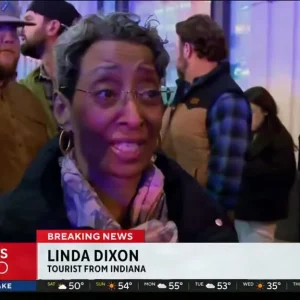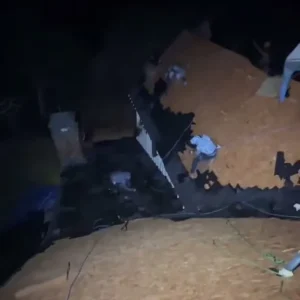🚨 BREAKING: The U.S. Military Is Now on High Alert off the Coast of Venezuela — One of the Largest Shows of Force in Years
The United States military has significantly increased its presence near Venezuela, marking one of the most substantial regional deployments in recent years and drawing global attention.
This heightened military posture signals Washington’s growing concern over regional instability, illicit activities, and geopolitical tensions developing rapidly across the Caribbean basin.
U.S. officials report that multiple naval assets, surveillance aircraft, and rapid-response forces are now operating close to Venezuelan territorial waters under elevated readiness levels.
The Pentagon states the move aims to deter escalating threats, ensure maritime security, and reinforce long-standing commitments to regional partners in the Western Hemisphere.
Sources suggest the deployment includes advanced destroyers, reconnaissance platforms, and support vessels capable of sustained operations across complex Caribbean maritime environments.
The increased activity comes as Venezuela faces deep political turmoil, economic collapse, and rising transnational crime networks affecting security across Latin America.
Analysts note that security conditions have deteriorated in recent months, prompting Washington to strengthen deterrence measures and monitor potential flashpoints near strategic sea routes.
Regional intelligence reports highlight concerns about narcotics trafficking, illegal mining operations, and unauthorized military movements linked to non-state actors operating within Venezuela.
The U.S. military presence also aims to reassure neighboring countries, many of which rely on American security cooperation to counter shared regional threats and instability.
Officials emphasize that the heightened alert is not a declaration of conflict but a proactive step to prevent conditions from spiraling into wider crises.
Despite these assurances, the scale of the deployment represents a rare show of force that has triggered debates among diplomats, analysts, and global observers alike.
Military experts indicate that such a concentration of assets suggests Washington is prepared for rapid crisis response should tensions escalate unexpectedly.
Some analysts argue the timing is linked to broader geopolitical competition, with rival nations expanding influence in Latin America, prompting Washington to reinforce its strategic foothold.
Others point to recent incidents involving Venezuelan patrol vessels and foreign-flagged ships, which have increased concerns about potential confrontations at sea.
Satellite imagery reviewed by independent defense researchers shows intensified naval movement, confirming that American vessels are maintaining active patrol routes near key maritime corridors.
This operational posture aligns with long-standing U.S. missions focused on preventing arms shipments, countering smuggling networks, and protecting freedom of navigation in international waters.
Diplomatic channels remain active, though communication between Washington and Caracas has grown increasingly strained due to political disputes and sanctions imposed in previous years.
Venezuela has condemned the U.S. deployment, labeling it an act of intimidation and accusing Washington of interfering in sovereign regional affairs.
State media in Caracas claim the maneuver is designed to pressure the government before upcoming political negotiations and international diplomatic summits.
However, U.S. officials insist the heightened alert level strictly addresses security concerns, not domestic Venezuelan politics or regime-change strategies.
Regional allies, including Colombia and several Caribbean partners, have expressed support for increased American vigilance aimed at protecting shared maritime boundaries.
Experts warn that misunderstandings or miscalculations could spark unintended confrontations, underscoring the importance of clear communication to avoid escalation.
Humanitarian organizations also monitor the situation closely, fearing that rising tensions may worsen migration flows from Venezuela’s ongoing social and economic crisis.
The Pentagon confirms it is coordinating closely with allied intelligence networks to identify emerging risks and ensure swift responses to evolving operational dynamics.
Maritime analysts emphasize that the Caribbean remains a crucial hub for global trade, making security in these waters essential for international economic stability.
As the situation develops, the deployment serves as a visible reminder of Washington’s strategic interest in maintaining influence and stability across the Western Hemisphere.
Observers expect additional updates in the coming days as more details emerge regarding the precise objectives and duration of this high-alert mission.
International media outlets continue tracking movements of U.S. assets, citing this operation as one of the most significant American military signals in the region this decade.
While no immediate conflict appears imminent, heightened vigilance reflects broader uncertainties shaping global security landscapes and regional power dynamics.
The Pentagon reiterates that all actions comply with international law and aim to safeguard maritime routes vital for global commerce and regional cooperation.
Military strategists caution that the presence of powerful assets elevates both deterrence and risk, depending on how regional actors interpret American intentions.
For now, Washington maintains a firm stance, asserting that increased readiness ensures stability and protects regional allies facing emerging threats.
The unfolding situation remains fluid, drawing close analysis from international security experts assessing possible shifts in Venezuela’s political and military landscape.
As global attention intensifies, the U.S. deployment symbolizes a decisive response to rising instability and demonstrates Washington’s continued commitment to Caribbean security.
Diplomats urge all parties to exercise restraint, emphasizing the importance of dialogue to prevent tensions from escalating into broader confrontation.
Despite uncertainties, the international community watches closely, recognizing that developments off Venezuela’s coast may shape regional geopolitics for years ahead.





